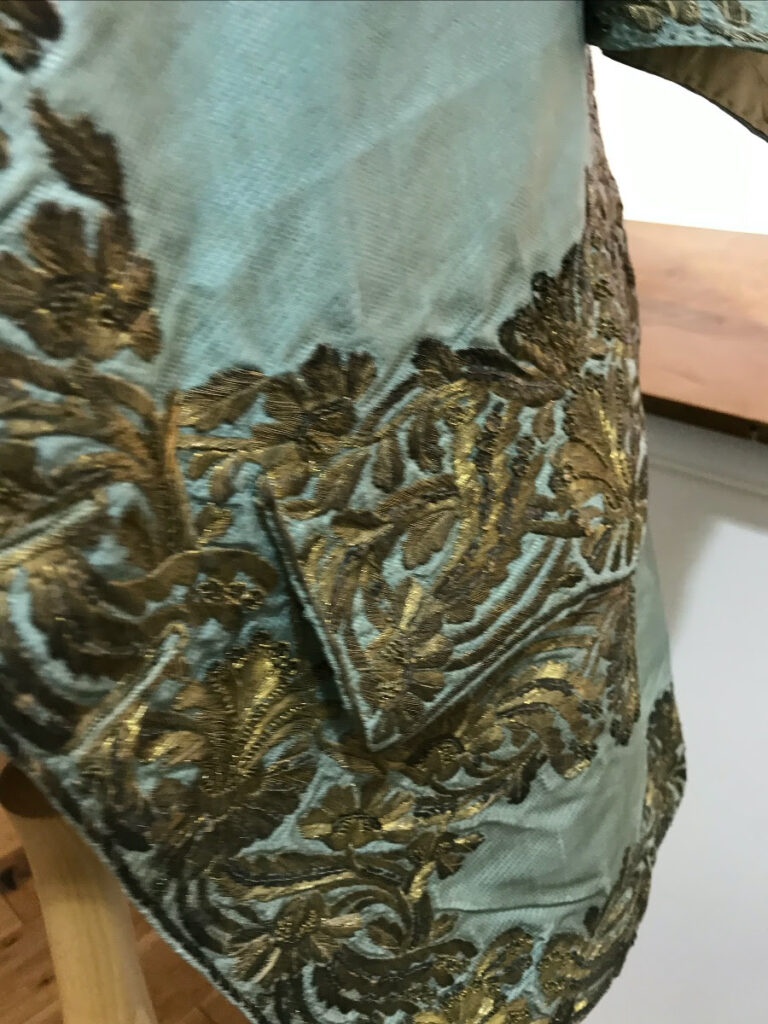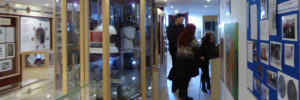Here you can find more information about some of our favourite items in the collection.
- Turner picture of Malmesbury Abbey
- Malmesbury Roman coin hoard
- Athelstan Penny
- Athelstan Replica Sword
- Iron Age Querns
- 18th century Fire Pump
- 19th century drawing of the top of the High Street
- A late medieval ampulla
- The Malmesbury Yard
- A leaded stained glass roundel from the White Lion Inn
- A 19th century quilt from Cole Park
- Jackets from Cole Park
Athelstan Replica Sword
On display in the museum is an archaeologically accurate replica of a sword in the Anglo Saxon tradition, such as would have been used by King Athelstan (924-939).
Our museum is named for this First King of all England and we also have on display a coin of his reign displaying his crowned head.
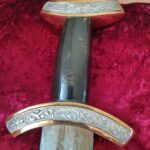
The sword blade was forged by renowned historical weapons blacksmith Hector Cole MBE, the hilt made and decorated by jeweller Tim Blades; both using authentic historical techniques. The design is based on a sword hilt in the Ashmolean Museum, Oxford. Hector specialises in the reconstruction of archaeological artefacts using the materials and techniques of ancient smiths, Tim in wax carving and casting.
Alongside the sword is a tablet showing a short film of the construction of the sword. This gives a good idea of the effort required to produce a sword ‘fit for a king’, with its beautiful patterning on the blade and detailed silver figuring on the hilt.
Swords were highly valued possessions not just as weapons but bearing symbolism around sovereignty, chivalry, nobility, status and have even been imbued with spiritual power in truth seeking, purity and cutting away ignorance.
The sword was commissioned by the King Athelstan First King of All England Trust on behalf of the Masonic Order of Athelstan, King Athelstan Memorial Trust and is on long term loan to the Museum from the Masonic Order.
The Iron Age Querns found in 2012
The Iron Age querns found during the excavation at St Joseph’s School are on display.
The stones are so heavy that two people can only just lift them together, so the strength and skill involved in creating this flour-milling tool can only be imagined.
The archaeologist thinks that one stone was broken during manufacture, at the time of the Iron Age, and was discarded on the site. However, another is an undamaged example of a Quern stone. Two such rounded stones were worked together using a pole in the middle that was pushed backwards and forwards to create the grinding action.
Athelstan Museum is grateful to St Joseph’s School and the Avon Archaeological Unit for this recent gift.
Fire Pump
Until recently, this was on loan to Wiltshire Fire Museum. It has now been returned, has undergone conservation treatment and is on display in the Tourist Information Centre. The 4 man manual fire engine, more strictly pump, was probably made by Samuel Phillips of New Surrey Street, Blackfriars, London in the second half of the 18th century; Richard Newsham, a pearl button maker from London made similar engines.
Samuel Phillips started making fire engines in 1760; in 1797 the firm became Phillips and Hopwood.
Josiah Wedgwood of pottery fame ordered in 1781 a one third size engine for his factory. It cost £40 but with extras; buckets, hoses, nozzles and special box the total was £58-17s-3d. Not good enough – Josiah had his name painted on each side; it cost him another 2 shillings.
The fire pump would have been conveyed to the fire by horse and cart, and then dragged as close to the fire as possible. Water would be fetched in buckets from the nearest source by a stream of helpers. The water was poured into the reservoir and 4 men pumping as hard as they could, would force the water up the hose so it could be played on the fire.
Not all houses were protected. If you were insured a plaque was displayed on the front. Subscribers had their fire put out free but had to pay for oiling and greasing the hose afterwards.
In 1974 a series of four commemorative stamps featuring fire engines was issued. The 10p stamp featured a Samuel Phillips fire engine.
“Top of the High Street” by F.Messiter
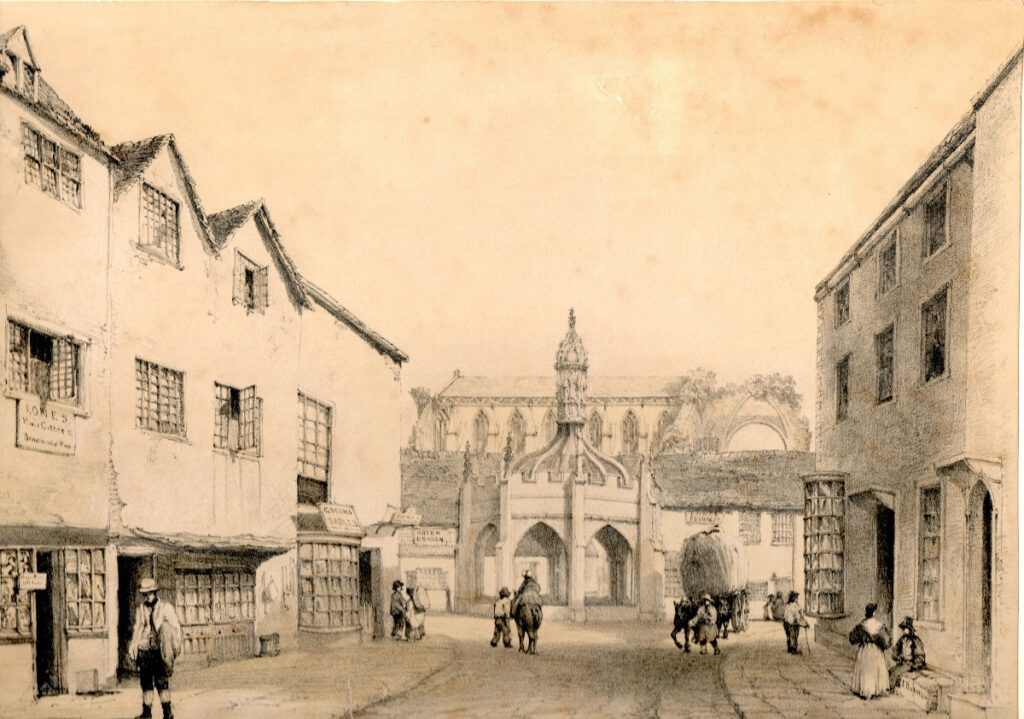
The original drawing for this was done in 1818 by F Messiter. Our print of his drawing is an 1860 Lithograph, credited to W Hanks of Malmesbury. It seems to have been acquired by the museum in 1978. In 2008 we also acquired a coloured version of this print as part of the major bequest from collector Richard Hatchwell.
Interesting things to note in the picture include the two inns in the Market Cross. The Green Dragon on the site of the Raj, and the Prince and Princess on the site of the Whole Hog.
Read more
You can also just make out a couple of the shop signs too. Jones “Hair Cutter” – no fancy salon names in those days – and Greens (or Greeves?) ‘Sadler’.
We have found no other information about F Messiter as an artist. A Frederick Messiter and his brother; tailors and drapers of Malmesbury; are mentioned as bankrupts in law reports of 1842. It may be the same person but that is pure speculation. Does anyone know more?
We have many fascinating pictures of Malmesbury from the 18th century onward, and when we can open the new gallery space on the mezzanine, many more of these can be shown to complement the Turner.
A Medieval Souvenir
One of the metal detector finds from the Garsdon area, now on permanent display in the Museum, is a beautiful, late medieval ampulla. The growth in the hobby of metal detecting has increased the number of medieval ampullae found across the country and reported to the Portable Antiquities Scheme.
This small trinket sheds quite a lot of light on the religious, social and cultural aspects of medieval life. Made from lead, they are often found in cultivated fields, as was the ampulla in the Museum.
Read more
Most ampullae have been deliberately damaged with the top ripped off perhaps in order to scatter the contents, probably holy water, onto a field to encourage a good harvest.
Ampullae were made as souvenirs, mass produced very cheaply to be bought and collected by pilgrims all across Europe, much like the ubiquitous fridge magnet today. They formed part of the medieval cult of saints whereby people would visit a shrine and want to take home with them a memento of their visit. The most common type of decoration is the shell, a design long associated with St James. The floral motif was also very popular, as was any design associated with the Virgin Mary such as the lily, the heart or the crown. The ampulla in the Museum has a four-petal flower on one side and a crown on the other suggesting homage to the Virgin.
Imagine the original owner of the ampulla spreading the contents onto the field in the hope of a bountiful harvest over 500 years ago…
The ‘Malmesbury Yard’
This object is the ‘Malmesbury Yard’, and an associated letter of 1893 from James Ward, County Inspector of Weights and Measures. These items came into the museum in 1978 or soon before. Unfortunately we have no record of how they arrived.
Read more
The definition and usage of the Standard Yard can be traced back to at least the Magna Carta in 1215.
The yard was defined as 36 inches, each inch being the length of 3 barleycorns.
King Henry VII, reigning 1485 to 1509, distributed Standard Yards (metal rods) throughout his kingdom. The ‘Malmesbury Yard’ is a little later than this, dating from 1654.
The total length of the Malmesbury Yard is actually one and a quarter yards, this being one ell (a measure once used in the textile industry). The standard yard is the distance between two blocks protruding from the rod.
The letter details the verification of the Malmesbury Yard against the Wiltshire standard in 1893. The first page is reproduced below.
The following extracts from the letter are particularly notable:
“The Standard Yard and Ell of the Borough of Malmesbury is dated 1654, being the time of the Protectorate of Oliver Cromwell.
…
The Standard has been very carefully compared with the Standard Yard No. 2174, verified by the Board of Trade Standards department Feb 11 1891 for the use of the County of Wilts, and the length of the Malmesbury Yard which is between the two shorter pillars is, notwithstanding its extreme antiquity and amount of usage it has undergone, now at the present day within .005in or one two-hundredth part of an inch of the said Standard 2174.
…
the Standard of the Borough of Malmesbury is undoubtedly an instrument of value and too much care cannot be taken in preserving it.
…
I have taken the liberty of enclosing the Standard in a Mahogany case, which may assist in protecting from damage, so interesting and valuable a relic of ancient times”
Read the full transcript
From the Wilts County Council Weights and Measures Office, May 29th 1893
Mr Mayor and Gentlemen
Through your kindness I have been allowed to examine and compare with the modern Standard yard of the County of Wilts, the interesting and ancient Standard measure of length of the Borough of Malmesbury.
I have taken the liberty of enclosing the Standard in a Mahogany case, which may assist in protecting from damage, so interesting and valuable a relic of ancient times, and I beg to bring to your notice the following particulars which may be of interest.
The Standard Yard and Ell of the Borough of Malmesbury is dated 1654, being the time of the Protectorate of Oliver Cromwell.
The original and only official verification which appears to have been made of this Standard was made in the City of London.
The Standard has been very carefully compared with the Standard Yard No. 2174, verified by the Board of Trade Standards department Feb 11 1891 for the use of the County of Wilts, and the length of the Malmesbury Yard which is between the two shorter pillars is, notwithstanding its extreme antiquity and amount of usage it has undergone, now at the present day within .005in or one two-hundredth part of an inch of the said Standard 2174.
By Order of Council made the fourth day of February 1879, the amount of error allowed on a Standard Yard, is one hundredth part of an inch. The Malmesbury Standard with its two hundred and thirty-nine years service shows, now, only half the amount of error in excess which is allowed.
The subdivisions of the Standard are not authentic, but have been marked on roughly with a coarse file by some enterprising custodian, and must not be taken as in any way representing measures of length.
The round brass rod Yard in the lid of the case is an exact yard, and by placing it between the pillars on the Malmesbury Standard no appreciable difference can be observed between the length of the two.
The length between the two end pillars of the Malmesbury Standard is forty-five inches, or five quarters of a yard, being the old English or Cloth Ell of the period, a measure which is now obsolete, and of which there is now no legal standard measure of length.
As a curiosity, and as a means of showing how inappreciable is the difference of length in the Standard Yards of 1654 and 1893 the Standard of the Borough of Malmesbury is undoubtedly an instrument of value and too much care cannot be taken in preserving it.
I am
Mr Mayor & Gentlemen,
Yours respectfully
James Ward
County Inspector of Weights and Measures, Swindon, Wilts
The White Lion Inn
This is the former hostelry in Gloucester Street; which probably dates back as far as the 12th century; and occasionally still opens its doors for Museum/Civic Trust events, thanks to current owners Frances and Paul Smith.
One of Collection Team member Christina Staff’s favourite items in the museum collection is this fabulous leaded stained glass roundel from the inn.
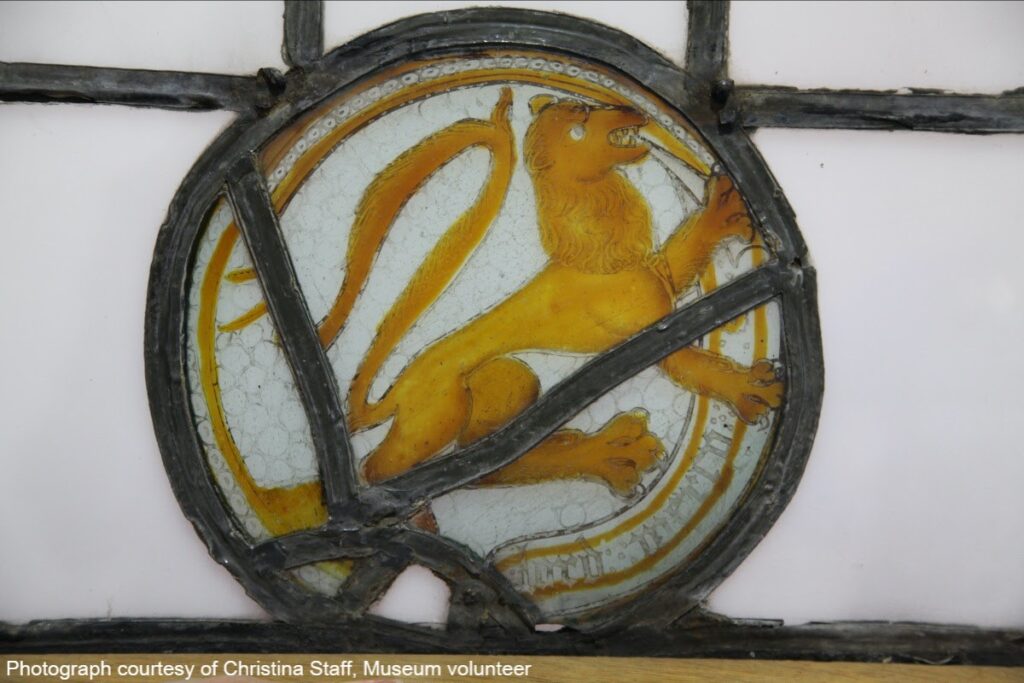
Charles Vernon’s Malmesbury’s Past, People and Places reports that the window was removed and donated to Athelstan Museum when the White Lion closed in 1970. The glass has been identified as 14th or 15th century. The inscription reads ‘O Mercy’. Its most recent outing from the Store was for the excellent U3A Local History Society display about Malmesbury Pubs and Inns.
The best known story about the White Lion is surely that of Hannah Twynnoy, and it does not need repeating here. However, it is a good reason to show another item from the collection. An image of poor Hannah’s encounter with the tiger, by Colin Forward. Unfortunately we only have a copy, rather than an original print, but it is a favourite of mine.
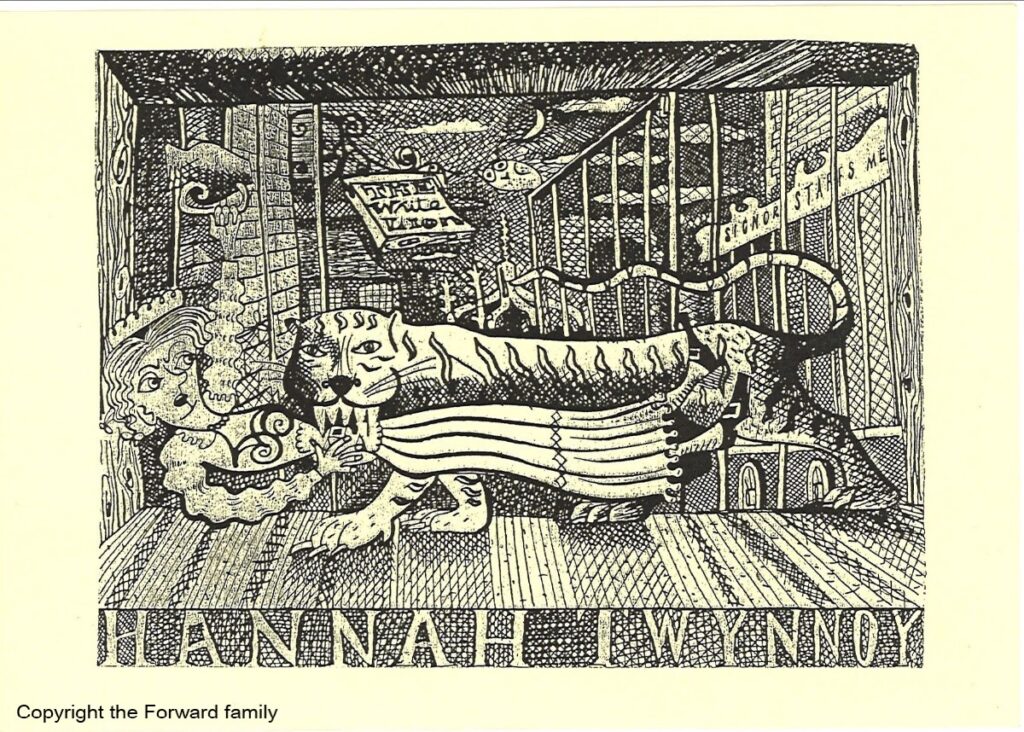
Drawing of Hannah Twynnoy by Colin Forward for a Souvenir Pamphlet on the occasion of a senior staff E.K.Cole Ltd party in 1956. “From the original foolscap dyeline pamphlet. They used a purple dye to print things in the drawing office at E K COLE … the original would have been drawn on their standard tracing paper using Indian ink.” (Tristan Forward).
The White Lion building itself looks quite different today than it did even in this photograph of 1878, also in the museum collection.
The bow window was removed in 1964 as it was being damaged by high vehicles. According to the museum catalogue, this picture was taken by William Hanks of Malmesbury. As an aside from the White Lion itself, the wider street scene is also interesting. In case anyone needs orienting, this is looking down to the mirror.
The Cole Park Quilt
By Janet Casselden
This quilt in our collection has not been on display since before I started volunteering at the museum in 2008 and when I found out that we had it I got very enthusiastic about seeing it. However, it was not until we moved everything to the new store that I eventually saw it unwrapped.
It is a large double bed quilt donated to the museum in, or shortly before, 1982 having been found in a house on the Cole Park Estate, possibly Stable Cottage. At the time of donation it was believed to date from the early 19th century.
It is a quilt that has seen a lot of use; some of the fabric has worn into holes and the areas which were probably white originally (particularly the reverse) are very soiled and grubby. The wool ‘batting’ (the middle layer) can be seen though some of the holes.
Read more
It was partially made using the English paper piecing method, where shapes are cut from scrap paper/card and the fabric is wrapped round each piece of paper before being joined together with tiny stitches. This can be seen clearly in the photo of the hexagons; a pattern known as grandmother’s garden.
In June of last year I was able to get the quilt out for a study session in the old Moravian Church. Members of my Art Quilt group attended and were able to look closely at the fabric and stitches. Some of the fabric appears to be the sort used for making dresses in the early 19th century, as worn by Jane Austen and her friends, suggesting that the initial dating could be correct?
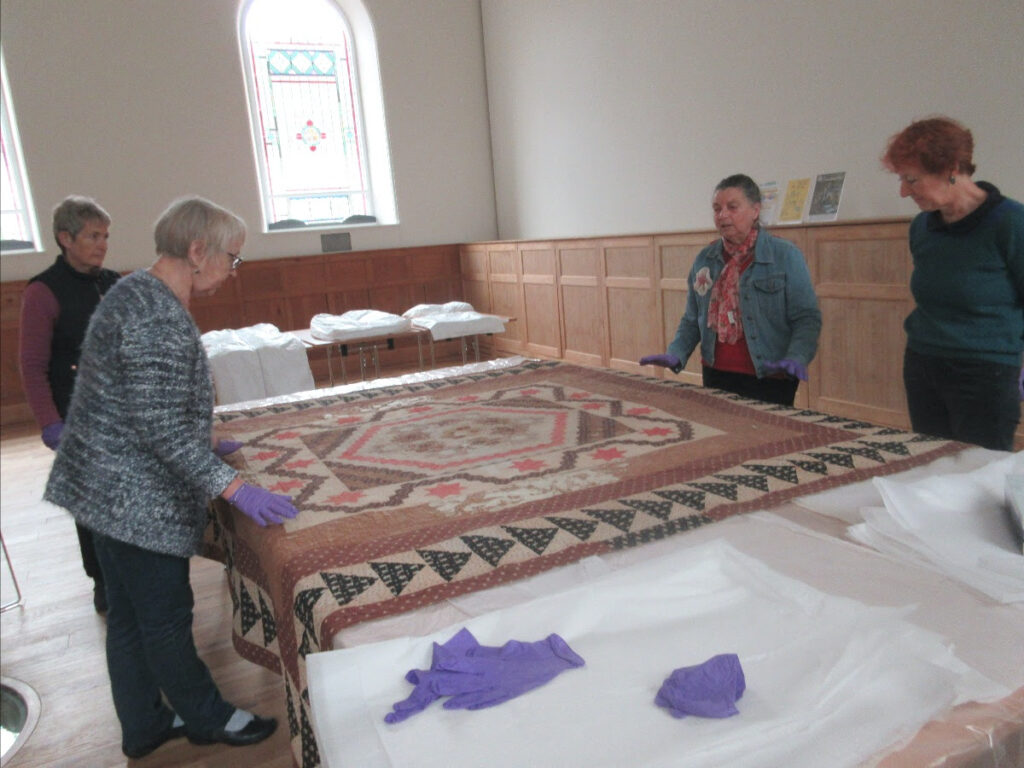
It was a particular pleasure to be able to show this item from our collection to a group who were as delighted as me to get up close to something handmade almost 200 years ago.
Two Georgian Jackets from Cole Park
By Janet Casselden
These fantastic jackets came into the collection from Cole Park before 1978 and were probably worn in the late 18th century by a member of the Lovell family.
They are items I have shown during the textile study days I have been able to hold since our purchase and refurbishment of the old Moravian Church.
As the photos show they are garments with a fair amount of ‘bling’ which shines when either sunlight or artificial light catches. When the pocket flaps are lifted the fabric of one and the embroidery of the second glows even without extra light! This section of both garments shows very little sign of wear as there are no actual pockets.
Read More
One is made of a heavy corded turquoise silk, predominantly lined with, what is now, quite a grubby silk. It was made for what I would term a rather portly gentleman, any of our manikins would need a cushion tied to their front to display the splendid gold metal embroidery and buttons.
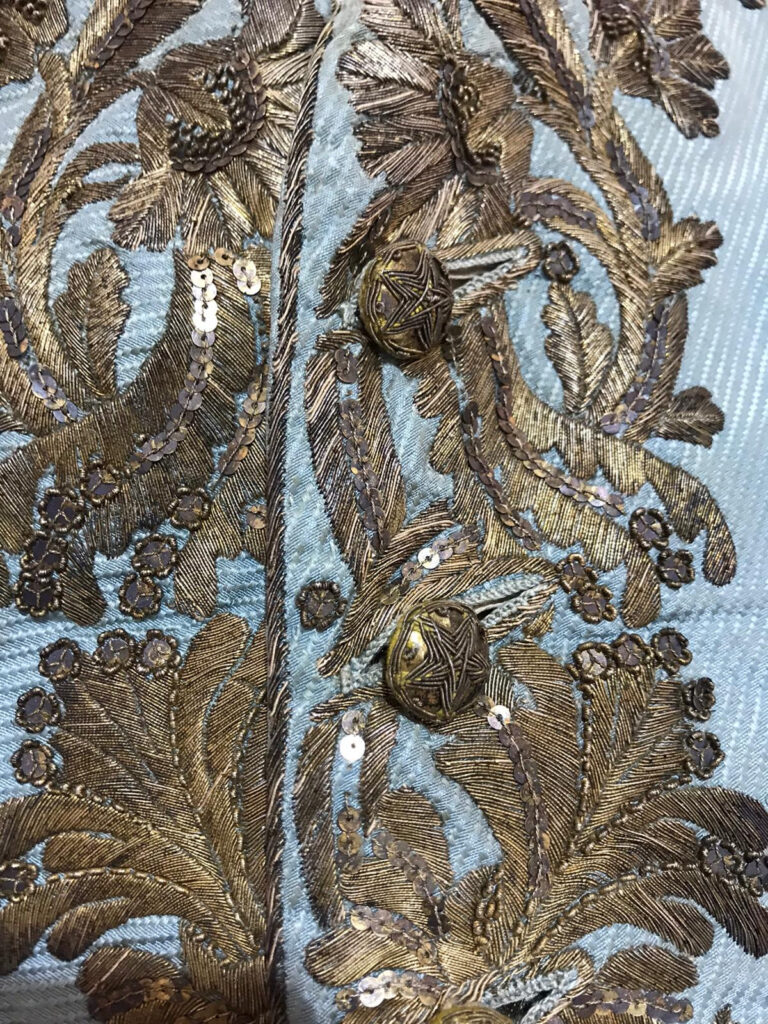
They would have been worn with knee breeches, with a sleeveless waistcoat and shirt underneath. Unfortunately we do not have these items, but we do have another similar sized jacket with breeches and a heavy outer coat to match made from a woven and patterned silk in brown and cream.
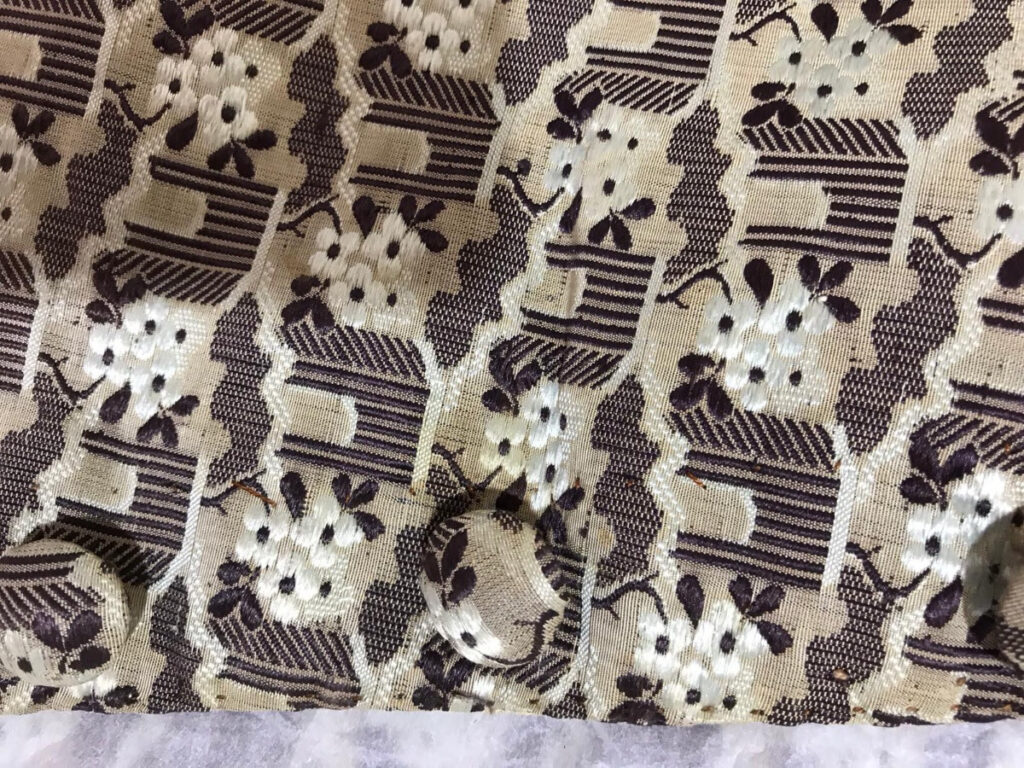
Every item of clothing from this period would have been made by hand. When a group of stitchers is able to get up close and has finished being amazed by the skill of the embroiderers and how well it has survived 200+ years, they want to look closely at the construction and the stitching. This too is amazing and does not disappoint; neat tiny stitches, and not a simple shape. The sleeves are made with a bend already in them – so the wearer would not have been able to hold his arms straight, and with all the metal and heavy silk they are not lightweight garments! On the turquoise jacket – is a lighter piece of fabric in both shoulder areas which allow movement, otherwise I think it would have been a most uncomfortable garment to wear.
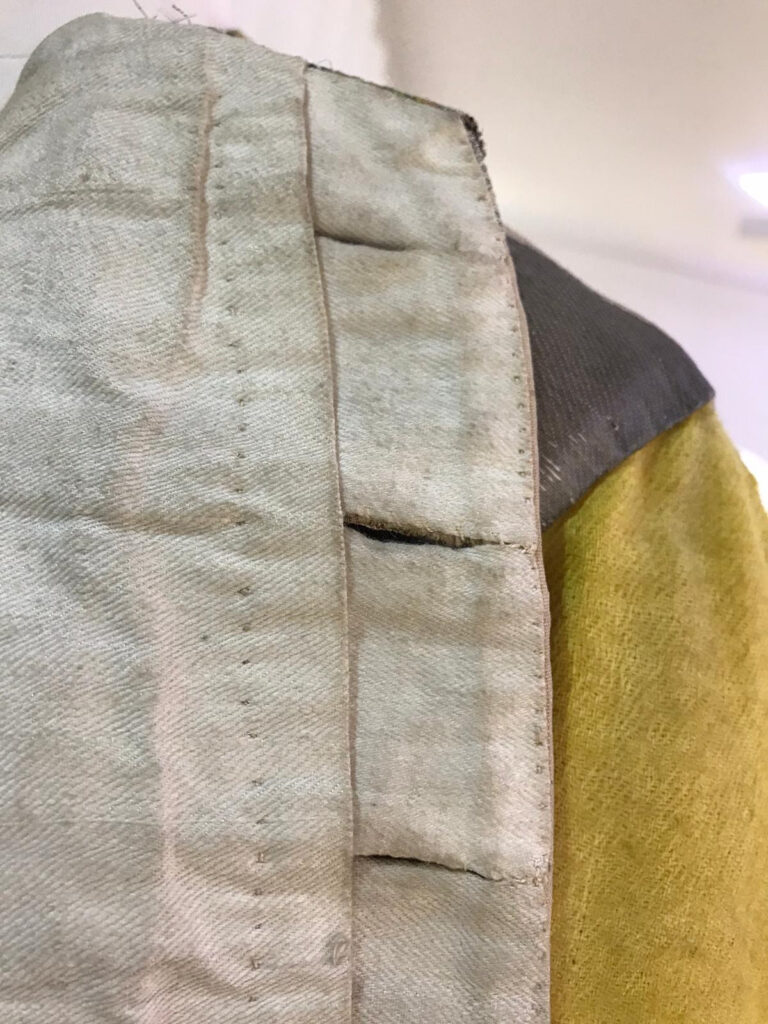
The embroidery on both jackets looks beautifully stitched, the colours of the silks used are still strong, it is only the metal threads which have tarnished with time. The designs are probably typical of the time and really deserve further study. A project for the future!
